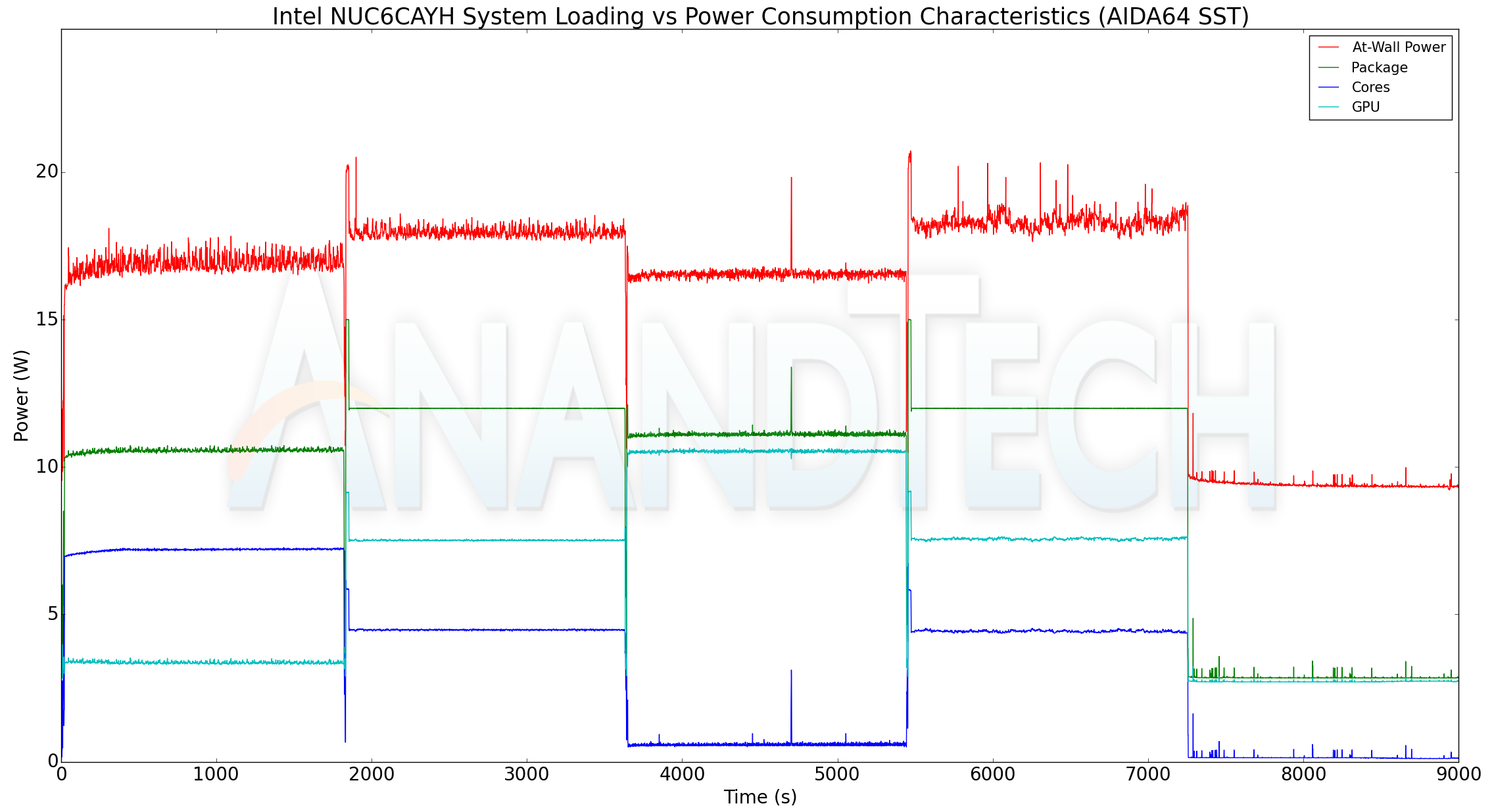Intel NUC6CAYH (Arches Canyon) Apollo Lake UCFF PC Review
by Ganesh T S on January 12, 2018 8:00 AM EST- Posted in
- Systems
- Intel
- NUC
- UCFF
- Apollo Lake
- Arches Canyon
Power Consumption and Thermal Performance
The power consumption at the wall was measured with a 4K display being driven through the HDMI 2.0 port. In the graphs below, we compare the idle and load power of the Intel NUC6CAYH with other low power PCs evaluated before. For load power consumption, we ran the AIDA64 System Stability Test with various stress components, as well as our power virus test, and noted the maximum sustained power consumption at the wall.


The Intel NUC6CAYH has a powerful CPU that wins in a majority of the presented benchmarks. But, it comes with a significant power penalty, both at idle and full loading.
Our thermal stress routine starts with the system at idle, followed by four stages of different system loading profiles using the AIDA64 System Stability Test (each of 30 minutes duration). In the first stage, we stress the CPU, caches and RAM. In the second stage, we add the GPU to the above list. In the third stage, we stress the GPU standalone. In the final stage, we stress all the system components (including the disks). Beyond this, we leave the unit idle in order to determine how quickly the various temperatures in the system can come back to normal idling range. The various clocks, temperatures and power consumption numbers for the system during the above routine are presented in the graphs below.
| Intel NUC6CAYH - AIDA64 System Stability Test | |||

According to the official specifications of the Intel Celeron J3455, the junction temperature of the SoC is 105C. We do not see the numbers go anywhere that in the AIDA64 SST processing of the system. Interestingly, the package power seems to be configured for around 12.5W instead of 10W (as dictated by the TDP).
The AIDA64 system stability test uses real-world workloads to stress the system components. However, power virus tests such as the Prime 95 torture test and Furmark stability test can subject the system to greater stress. We repeated our thermal stress routine with 30 minutes of Prime 95 (v29.1), followed by 30 minutes of Prime 95 and Furmark (1.19.1). The Prime 95 load was then removed, and the GPU stressing Furmark test was allowed too run for another 30 minutes. The various clocks, temperatures and power consumption numbers for the system during the above routine are presented in the graphs below.
| Intel NUC6CAYH - Custom System Stability Test | |||

Here, we see the temperatures going up to 100C, but there is no throttling involved. Peak sustained power consumption numbers are also higher than what we encountered in the AIDA64 system stability test.










54 Comments
View All Comments
DSGT_Crockett - Thursday, January 18, 2018 - link
Interesting to me that one of the ~"usable" PCI-E lanes is 'taken up' by a Realtek NIC on an Intel ~AIO board ass'y. Realtek must really be giving those SOBs away for Intel not to have gone with their own branded NICs; but I realise as I type this that I may be playing the fool a couple ways, not least of which is a dire disconnection from mini/micro/whatever-computer equipment, and by no means do I mean to bang on your expert staff's doors with this ~obvious observation. Hell, it may have even been covered in the parts of the article I skimmed (:< I'm drunk, okay?) but I felt compelled to hit up the first page of the article with this because I'm used to Intel pushing their own network stuff _really_ hard. What gives?mode_13h - Saturday, January 20, 2018 - link
Yeah, it does seem weird, but does Intel even still make single-port Gig-E chips? It seems like their dedicated Ethernet silicon is probably focused on higher speeds & port-counts, while the low-end is probably integrated into their South Bridge chips (which this doesn't have, since it's an integrated SoC - mainly targeted at devices that lack Ethernet).Anyway, don't drunkpost. Go drink some coffee, tea, or go sleep it off.
sf101 - Monday, January 22, 2018 - link
wow this has a VGA out.That's surprising
Intel has really flip flopped on a standard Video output on these thats for sure.
sometimes HDMI sometimes only MINI - sometimes Displayport or only mini .. very surprised they added a VGA tbh.
Most wont understand this but upgrading a unit for older POS systems is a pain sometimes but adding a VGA adapter makes that far easier.
mode_13h - Friday, February 2, 2018 - link
For a lot of industrial and infrastructure applications, VGA is still in use. Not that this is exactly an industrial PC...